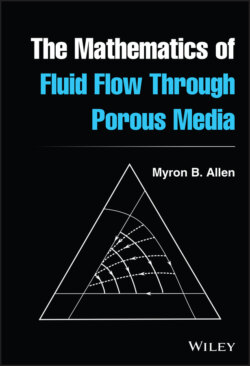Читать книгу The Mathematics of Fluid Flow Through Porous Media - Myron B. Allen III - Страница 17
2.1.1 Referential and Spatial Coordinates
ОглавлениеIn continuum mechanics, the term body refers to a collection of particles, sometimes called material points. A subset of the body that is a body in its own right is a part of the body. We assign to each body a reference configuration, which associates with the body a region in three‐dimensional Euclidean space. In the reference configuration, each particle in the body has a position , unique to that particle, as shown in Figure 2.1. The vector serves as a label, called the referential or Lagrangian coordinates of the particle. As with a person's home address, from a strictly logical point of view the particle need not ever occupy the point . That said, in some applications it is useful to choose the reference configuration in a way that associates each particle with a position that it occupies at some prescribed time, for example .
Figure 2.1 A reference configuration of a body, showing the referential coordinates used to label a particle according to its position in the reference configuration.
The central aim of kinematics is to describe the trajectories of particles, that is, to determine the position in three‐dimensional Euclidean space that each particle occupies at every time . For this purpose we assume that there exists a one‐parameter family of vector‐valued functions, time being the parameter, that has the following properties.
1 The vector , having dimension L, gives the spatial position of the particle at time .
2 At each time , the function of the referential coordinates is one‐to‐one, onto, and continuously differentiable with respect to .
3 Also at each fixed time , has a continuously differentiable inverse such that . That is, tells us which particle occupies the spatial position at time .
4 For each value of the coordinate , the function is twice continuously differentiable with respect to .
The function is the deformation of the body, illustrated in Figure 2.2. We call the vector the spatial or Eulerian coordinates of the particle at time .
Figure 2.2 The deformation mapping the reference configuration onto the body's configuration at time .
Figure 2.3 Regions and occupied by a body in two reference configurations, along with the corresponding deformations and that map a given particle onto a position vector at time .
Exercise 2.1 Let and be the regions occupied by a body in two different reference configurations, giving the referential coordinates of a certain particle as and , respectively, as illustrated in Figure 2.3. Let and , respectively, denote the deformations associated with these two reference configurations. Thus the spatial position of the particle at time is . Justify the relationship . This relationship makes it possible to reconcile the analyses of motion by observers who choose different reference configurations.
